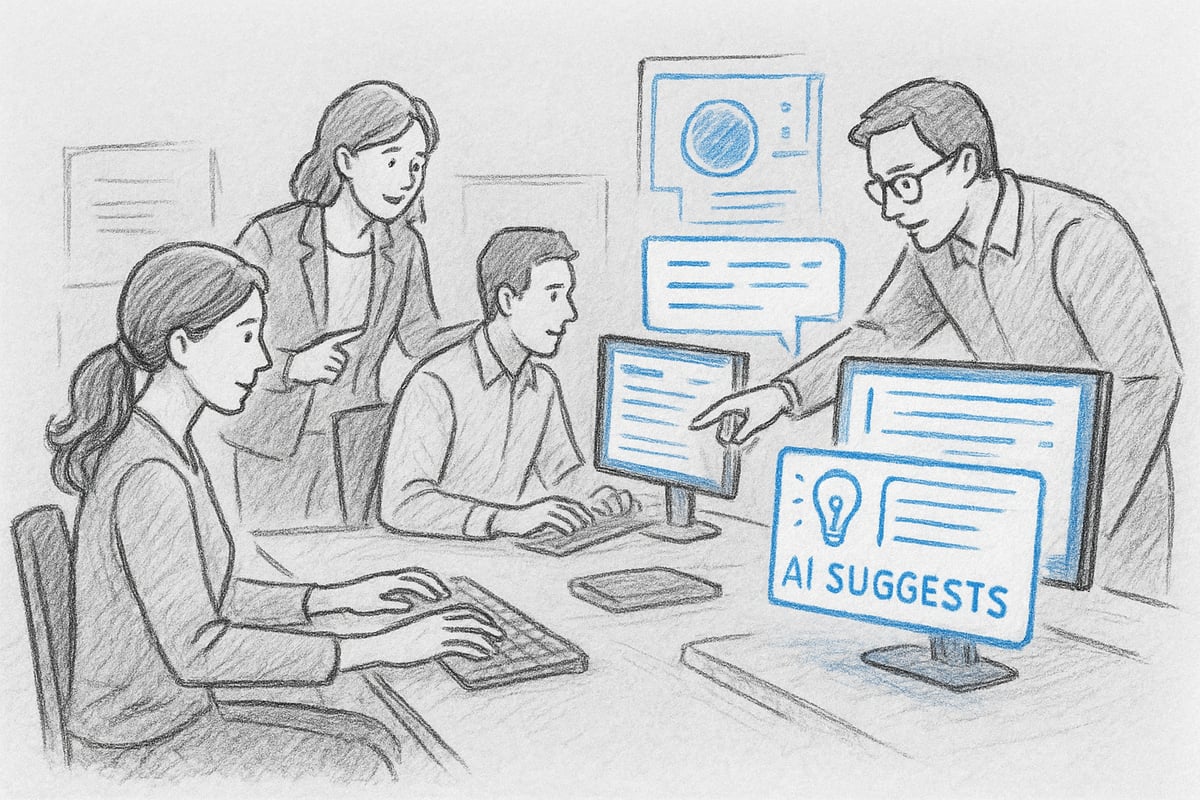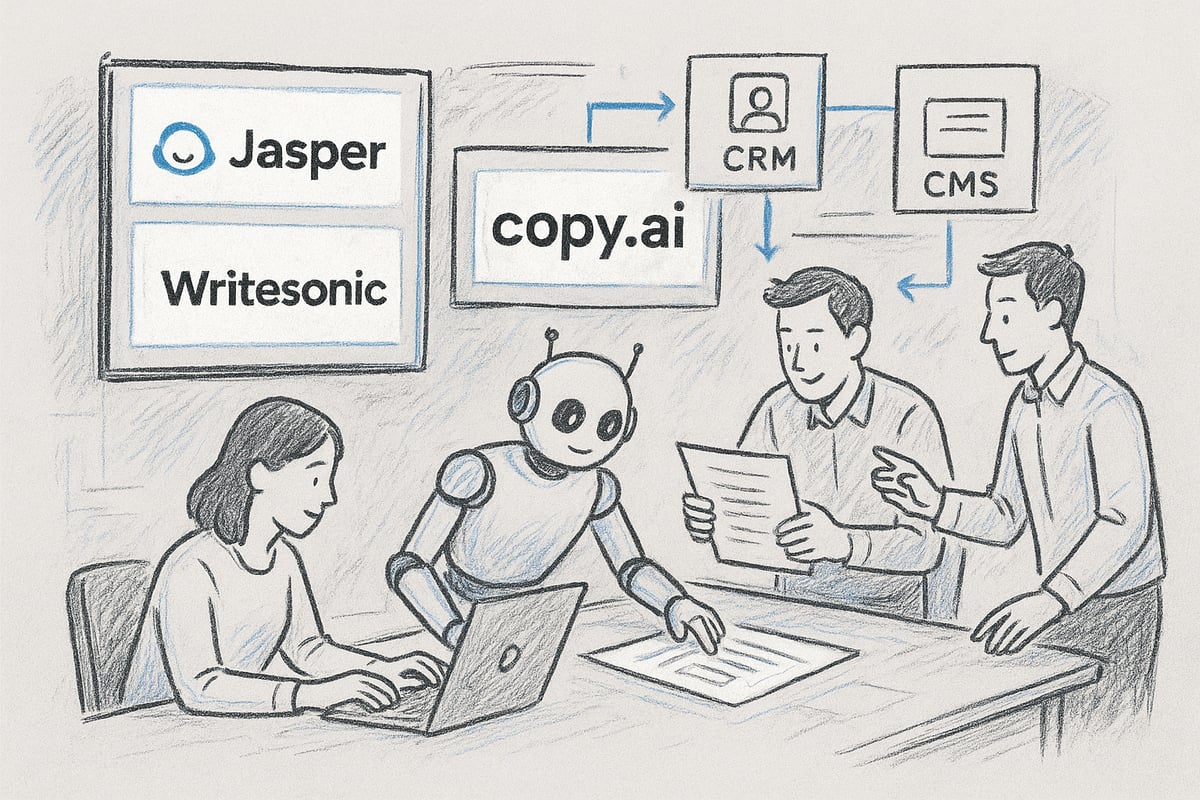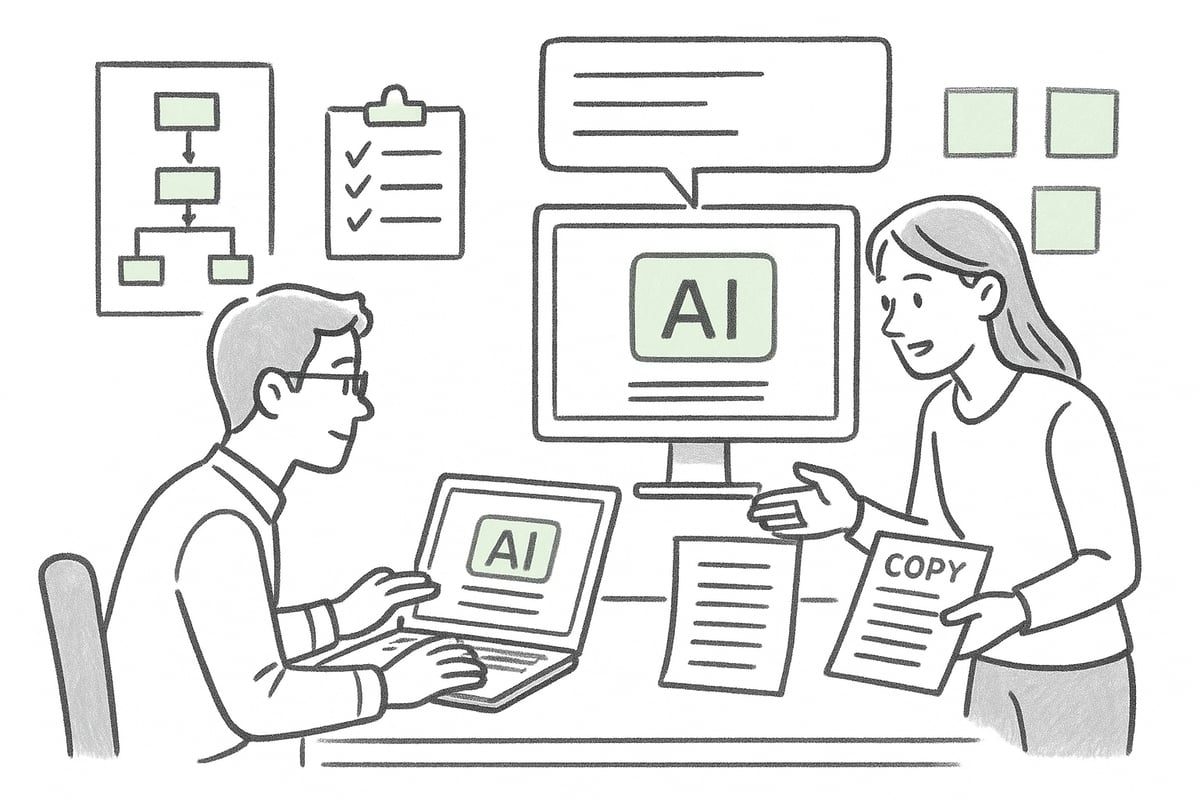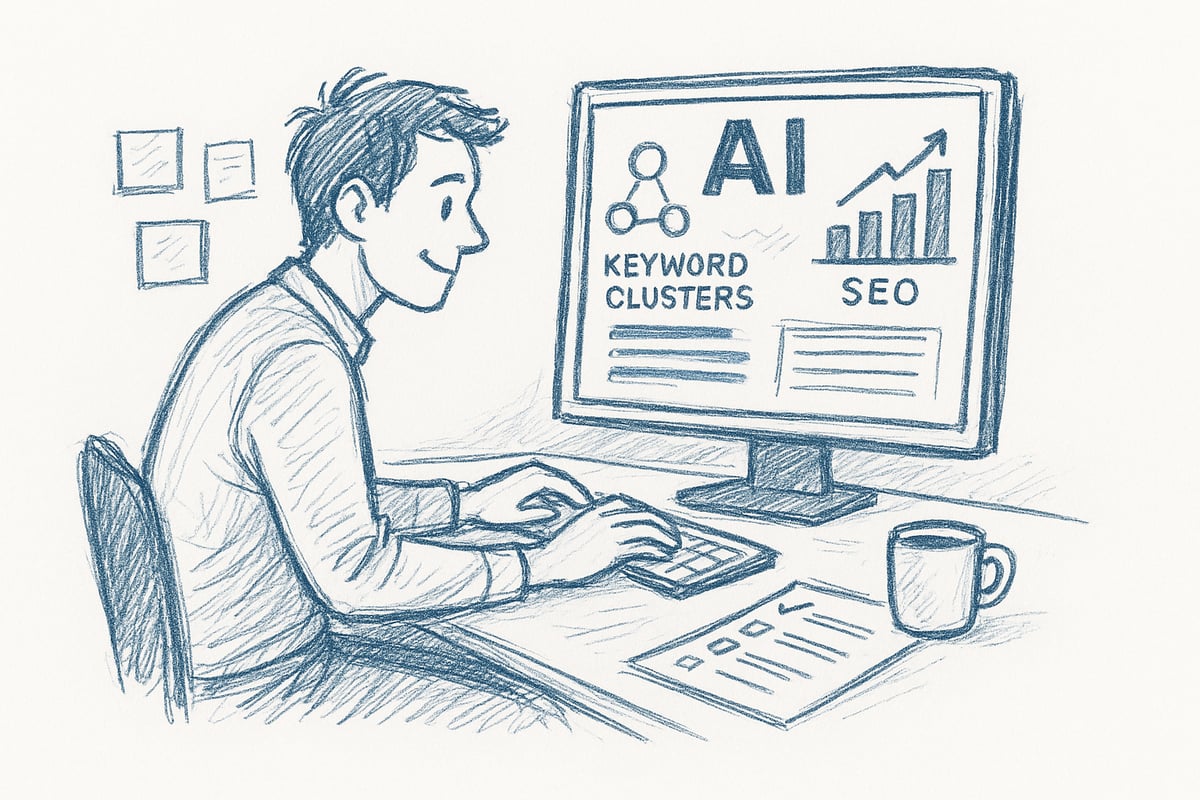Imagine transforming your content strategy with copywriting artificial intelligence, where ideas turn into high-impact copy in seconds. In 2025, this technology is not just a trend but a game changer, empowering marketers to create smarter, faster, and more persuasive content.
This comprehensive guide shows you how to harness the full potential of AI-powered copywriting, from understanding its evolution to selecting essential tools and integrating them seamlessly into your workflow. You will also discover practical optimization tips and explore what the future holds for this rapidly advancing field.
Ready to boost efficiency, drive higher ROI, and become a leader in digital marketing? Dive in and unlock the secrets to copywriting success with artificial intelligence.
The Evolution of AI in Copywriting
The landscape of copywriting artificial intelligence has shifted dramatically over the past decade. Early AI assistants like Grammarly and QuillBot focused mainly on grammar correction and paraphrasing, but these tools had clear limitations in creativity and context. The introduction of GPT-3 marked a significant leap, enabling more sophisticated content automation. By 2024, advancements such as GPT-4 and Google Gemini further transformed the field, driving wider adoption. According to HubSpot, over 80% of marketers leveraged AI tools for content in 2024. For instance, brands began using AI-driven solutions to generate personalized email campaigns, achieving higher open and conversion rates. For a deeper dive into these trends, see Marketing AI strategies and trends.

Milestones in AI-Powered Copywriting
Copywriting artificial intelligence has undergone a series of breakthroughs. Early AI writing assistants helped improve grammar and style, but lacked the ability to create original content. The launch of GPT-3 enabled machines to generate coherent and engaging copy for various formats. This milestone led to rapid innovation, with GPT-4 and Google Gemini delivering even more advanced capabilities. Adoption soared, with over 80% of marketers using AI tools by 2024. Brands like major retailers harnessed AI for email marketing, automating campaign creation and A/B testing at scale. These milestones paved the way for smarter, more creative content strategies.
Key Drivers of AI Adoption in Content Creation
Several factors have fueled the surge in copywriting artificial intelligence adoption. Marketers face growing demands for high-volume, personalized content across channels. AI tools reduce costs and save time, making it easier to scale campaigns. Enhanced data analysis helps teams understand audience preferences and optimize messaging. Seamless integration with marketing automation platforms further boosts efficiency. For example, e-commerce businesses now use AI to generate tailored product descriptions, improving both SEO and user experience. The ability to quickly adapt content to market trends and customer behavior has become a critical driver for businesses of all sizes.
Common Misconceptions and Challenges
Despite its rapid growth, copywriting artificial intelligence still faces skepticism and challenges. Many believe that AI will replace human creativity, but this is a misconception. Concerns about content quality and originality persist, as AI-generated copy can sometimes lack nuance. Legal and ethical issues, such as plagiarism and copyright, require careful oversight. Another challenge is addressing bias and misinformation that may emerge from AI outputs. According to the Content Marketing Institute, 62% of marketers worry about the accuracy of AI-generated content. These concerns highlight the need for ongoing human review and clear editorial standards.
The Human-AI Collaboration Model
The future of copywriting artificial intelligence lies in collaboration, not replacement. Human editors play a crucial role in refining AI-generated drafts, ensuring content aligns with brand voice and goals. By combining the efficiency of AI with the creativity of skilled writers, agencies and brands can streamline workflows and enhance quality. Editorial teams at leading agencies often use AI to produce first drafts, then rely on human expertise for final editing and strategy. This hybrid approach offers the best of both worlds: rapid content production and authentic storytelling. Ultimately, AI serves as a co-writer, empowering rather than replacing creative professionals.
Essential AI Tools and Platforms for Copywriting in 2025
The landscape of copywriting artificial intelligence is rapidly evolving, with innovative tools reshaping how marketers and writers approach content creation in 2025. Sophisticated platforms now offer unprecedented capabilities, helping businesses scale their messaging while maintaining quality and consistency.

Top AI Copywriting Tools Overview
In 2025, the market for copywriting artificial intelligence tools continues to expand. Leading platforms like Jasper, Copy.ai, and Writesonic offer unique features such as advanced tone control, multilingual support, and seamless integrations with marketing platforms.
Jasper's user base grew by 40% in 2024, reflecting the growing trust in AI-driven content solutions. Each tool varies in pricing, scalability, and core strengths. For a detailed breakdown of the best options, visit AI tools for marketing copy.
Before choosing, consider factors like ease of use, template variety, and update frequency. Staying informed about the latest capabilities ensures your copywriting artificial intelligence strategy remains competitive.
Specialized AI Solutions for Different Content Types
Copywriting artificial intelligence platforms now cater to a wide array of content needs. Whether it's long-form articles, engaging social media posts, compelling ad copy, or automated email sequences, specialized tools have emerged for every use case.
SEO-focused solutions like Surfer AI and Scalenut help optimize copy for search rankings, while Writesonic’s e-commerce templates streamline product description creation. SaaS companies are leveraging AI to generate high-converting landing pages, saving both time and creative energy.
Selecting the right tool for your content type is essential for achieving consistent results and maximizing the benefits of copywriting artificial intelligence.
Integrating AI with Existing Marketing Stacks
A seamless workflow is vital for copywriting artificial intelligence success. Modern AI tools offer robust API connections, enabling integration with CRMs and CMS platforms. This allows for smooth automation of campaign management and content deployment.
For example, marketers use Zapier to sync AI-generated copy directly with HubSpot, reducing manual effort and accelerating go-to-market timelines. These integrations help teams focus on strategy and creativity rather than repetitive tasks.
By embedding copywriting artificial intelligence within your marketing stack, you unlock faster content cycles and greater productivity across campaigns.
Evaluating AI Tool Performance and ROI
Measuring the impact of copywriting artificial intelligence is crucial for ongoing success. Key metrics include engagement rates, conversion percentages, and readability scores. Marketers often conduct A/B tests comparing AI-generated copy with human-written alternatives to identify what resonates best.
Recent data shows 55% of marketers achieved higher click-through rates using AI-assisted copywriting. For both small businesses and enterprises, a thorough cost-benefit analysis ensures the chosen solution aligns with budget and growth targets.
Regular performance reviews help refine your approach, ensuring copywriting artificial intelligence delivers maximum ROI.
Security, Privacy, and Compliance Considerations
As copywriting artificial intelligence becomes deeply integrated into content workflows, safeguarding data is paramount. AI platforms must adhere to GDPR and CCPA standards, ensuring responsible data handling and storage.
Risks such as proprietary data leaks or unauthorized content use underscore the need for vendor transparency and audit trails. Always verify how your AI provider manages sensitive information, and document compliance processes internally.
Protecting your brand and audience requires a proactive approach to security and privacy within every copywriting artificial intelligence initiative.
Step-by-Step Guide: Implementing AI Copywriting in Your Workflow
Implementing copywriting artificial intelligence into your content workflow can seem daunting, but a clear, methodical approach ensures success. By following these six strategic steps, your business can unlock measurable gains in efficiency, quality, and marketing impact. Here’s how to seamlessly integrate copywriting artificial intelligence for sustainable results.

Step 1: Assess Your Content Needs and Goals
Start by mapping your existing content processes and identifying bottlenecks. Which areas require more speed, volume, or personalization? Pinpoint high-impact applications for copywriting artificial intelligence, such as scaling product descriptions or automating email campaigns. Set measurable objectives for AI integration, like boosting engagement or reducing turnaround time. For example, an e-commerce brand might aim to double product page output per week. Include stakeholders from marketing, sales, and IT to ensure alignment on goals. This foundational assessment sets the stage for targeted, successful AI adoption. Be specific and realistic when defining what success will look like.
Step 2: Select the Right AI Tools
With clear goals, evaluate AI platforms that align with your content types, language needs, and scalability requirements. Consider trial periods to benchmark performance and gather team feedback. Look for solutions that integrate smoothly with your existing systems. For agencies, selecting platforms that support multiple client accounts, like Jasper, can streamline operations. Involve key stakeholders in the selection process to ensure buy-in and usability. For an in-depth exploration of available options, see Artificial intelligence marketing solutions. Choosing the right tool is critical to maximizing the benefits of copywriting artificial intelligence.
Step 3: Train AI Models on Brand Voice and Guidelines
To achieve consistent, on-brand messaging, train your chosen AI on your unique style and terminology. Upload brand assets, tone guidelines, and sample content. Use prompt engineering to instruct the AI on voice and context, minimizing generic outputs. For example, a SaaS company can maintain a technical yet approachable tone across all channels by fine-tuning its AI prompts. Regularly update the training data as your brand evolves. This alignment ensures that copywriting artificial intelligence produces content that resonates with your audience and supports your overall brand strategy.
Step 4: Integrate AI into Content Production Workflows
Design workflows that blend AI-generated drafts with human review. Use collaboration tools like Trello or Asana to track tasks and approvals. Automate initial content creation with copywriting artificial intelligence, then assign editors to refine and fact-check outputs. For example, marketing teams can automate first drafts for blog posts, while editors ensure accuracy and polish. Establish clear checkpoints for review and feedback. Integration with platforms such as CRMs and CMSs can further streamline the process. This hybrid approach leverages both AI efficiency and human expertise for superior content quality.
Step 5: Monitor, Test, and Optimize Outputs
Set clear KPIs, such as readability, SEO performance, and conversion rates, to measure the impact of copywriting artificial intelligence. Implement A/B testing to compare AI-generated copy with human-written alternatives. Collect user feedback and analyze engagement data to identify areas for improvement. Continuously refine prompts and workflows based on performance insights. According to industry studies, 70 percent of marketers saw higher engagement after optimizing their AI prompts. This iterative process ensures that your content remains effective and aligned with your business objectives.
Step 6: Address Legal, Ethical, and Quality Concerns
Implement robust fact-checking and plagiarism detection protocols for all AI-generated content. Ensure transparency by disclosing when content is created with copywriting artificial intelligence, especially in regulated industries. Stay informed about evolving legal standards around data privacy, copyright, and AI usage. Document editorial oversight, and establish clear accountability for final content approval. Regular training for your team on ethical AI practices will help mitigate risks. By prioritizing quality, compliance, and transparency, you safeguard your reputation and maintain audience trust.
Optimizing AI-Generated Copy for SEO and Engagement
Optimizing copywriting artificial intelligence outputs for SEO and user engagement is essential for modern marketers. With the right strategies, AI-generated content can be both search-friendly and highly compelling to readers. Let us explore the key approaches for maximizing the impact of your AI-powered copy.

Advanced Prompt Engineering for SEO
Prompt engineering is the backbone of effective copywriting artificial intelligence for SEO. Crafting precise prompts guides the AI to produce keyword-rich, relevant, and context-aware content. Use clear instructions, include target keywords, and specify content structure. Many marketers rely on tools like Surfer AI for keyword clustering, which helps identify trending topics and user questions.
For example, starting prompts with "Write a 500-word article targeting the keyword 'copywriting artificial intelligence' and include FAQs" often yields more SEO-friendly content. For a deeper dive into the latest AI tools that support advanced prompt engineering, check out Top AI Copywriting Tools 2024.
Enhancing Brand Voice and Personalization
Consistency in brand voice is crucial for audience trust. With copywriting artificial intelligence, you can fine-tune outputs for different audience segments by training AI models on brand guidelines, tone, and preferred vocabulary. Upload style guides or sample content to your chosen platform, ensuring every generated piece aligns with your brand identity.
Personalization goes further by allowing AI to create dynamic content. For instance, marketers use AI to tailor email copy or product recommendations based on user behavior, driving higher conversion rates. Case studies show that brands leveraging personalized AI copy see significant engagement boosts.
Fact-Checking and Quality Assurance
Quality assurance remains vital in copywriting artificial intelligence workflows. Integrate plagiarism checkers like Copyscape and grammar tools such as Grammarly to ensure originality and correctness. Establish human review protocols, especially for sensitive industries like healthcare or finance.
A robust QA process might include a checklist for fact verification, style consistency, and compliance with regulations. Many organizations adopt a two-step workflow: automated draft creation followed by human editing, minimizing errors while maintaining efficiency.
Leveraging AI Analytics for Content Performance
Monitoring performance is fundamental when using copywriting artificial intelligence. Real-time analytics dashboards provide insights into how AI-generated content performs regarding engagement, CTR, and SEO ranking. Some AI platforms offer predictive suggestions, like improving headlines or adjusting word count for better results.
Recent data reveals that 60% of marketers utilize AI analytics for strategy decisions. For more about evolving content marketing trends, explore the insights from AI Content Marketing Trends 2025.
Balancing Automation with Human Creativity
While copywriting artificial intelligence excels at speed and scale, human creativity remains irreplaceable. The best results come from a balanced approach: use AI for initial drafts, data-driven suggestions, and repetitive tasks, while relying on human writers for creative ideation and nuanced storytelling.
Encourage collaboration by providing creative briefs for AI-generated campaigns, then refine outputs through brainstorming sessions. This hybrid model ensures authenticity and keeps your content strategy both innovative and relatable.
Future Trends and Innovations in AI Copywriting
The future of copywriting artificial intelligence is rapidly taking shape, introducing advanced technologies that will redefine digital marketing. As we look ahead, several trends are set to transform how brands, agencies, and creators approach content strategy and execution.
Next-Generation AI Models and Capabilities
Next-generation copywriting artificial intelligence models are becoming multimodal, seamlessly processing text, images, and even video. This advancement enables real-time content personalization, letting brands tailor messages at the moment of interaction. AI chatbots now generate instant, context-aware responses, enhancing customer engagement across platforms.
The adoption of these models is accelerating, with 45% of marketers planning investments in multimodal AI by 2026, according to Gartner. The expanding market for AI writing tools is also fueling innovation; you can review more about this rapid growth in the AI Writing Tools Market Growth report. As these platforms evolve, expect even deeper integration of copywriting artificial intelligence into everyday workflows.
The Rise of Hyper-Personalized Content
Copywriting artificial intelligence is ushering in an era of hyper-personalization. By leveraging AI-driven micro-segmentation, marketers can predict user behaviors and deliver highly relevant messaging. Predictive copywriting adjusts offers, calls-to-action, and even product recommendations based on real-time analytics.
For example, e-commerce brands now generate individualized offers for each user, boosting conversion rates and customer satisfaction. A leading subscription box company recently increased retention by deploying AI-powered, segment-specific content. As these capabilities mature, expect hyper-personalized experiences to become the standard in digital marketing.
Ethical AI and Responsible Content Creation
With the rise of copywriting artificial intelligence, ethical considerations are more important than ever. Addressing bias, misinformation, and transparency is essential for building trust. Industry best practices now include clear disclosure when content is AI-generated, as 68% of consumers want this transparency according to Pew Research.
Responsible content creation also involves regular audits for bias and factual accuracy. Standards are evolving, ensuring that AI-generated outputs reflect brand values and respect legal boundaries. Marketers must stay proactive, establishing guidelines and monitoring systems to uphold integrity in all content.
Preparing for the Changing Landscape
As copywriting artificial intelligence becomes integral to marketing, teams must evolve. Upskilling in prompt engineering, data analysis, and AI collaboration is crucial for staying competitive. Content strategies need to adapt quickly to changing algorithms and new AI capabilities.
Many marketing teams are embracing continuous learning, using performance metrics to refine both human and AI contributions. Comparative studies, such as those found in AI vs Human Copywriter Performance Statistics 2025, highlight the shifting dynamics between technology and creative professionals. Ultimately, marketers will guide the strategic use of copywriting artificial intelligence, ensuring that creativity and authenticity remain at the forefront.
